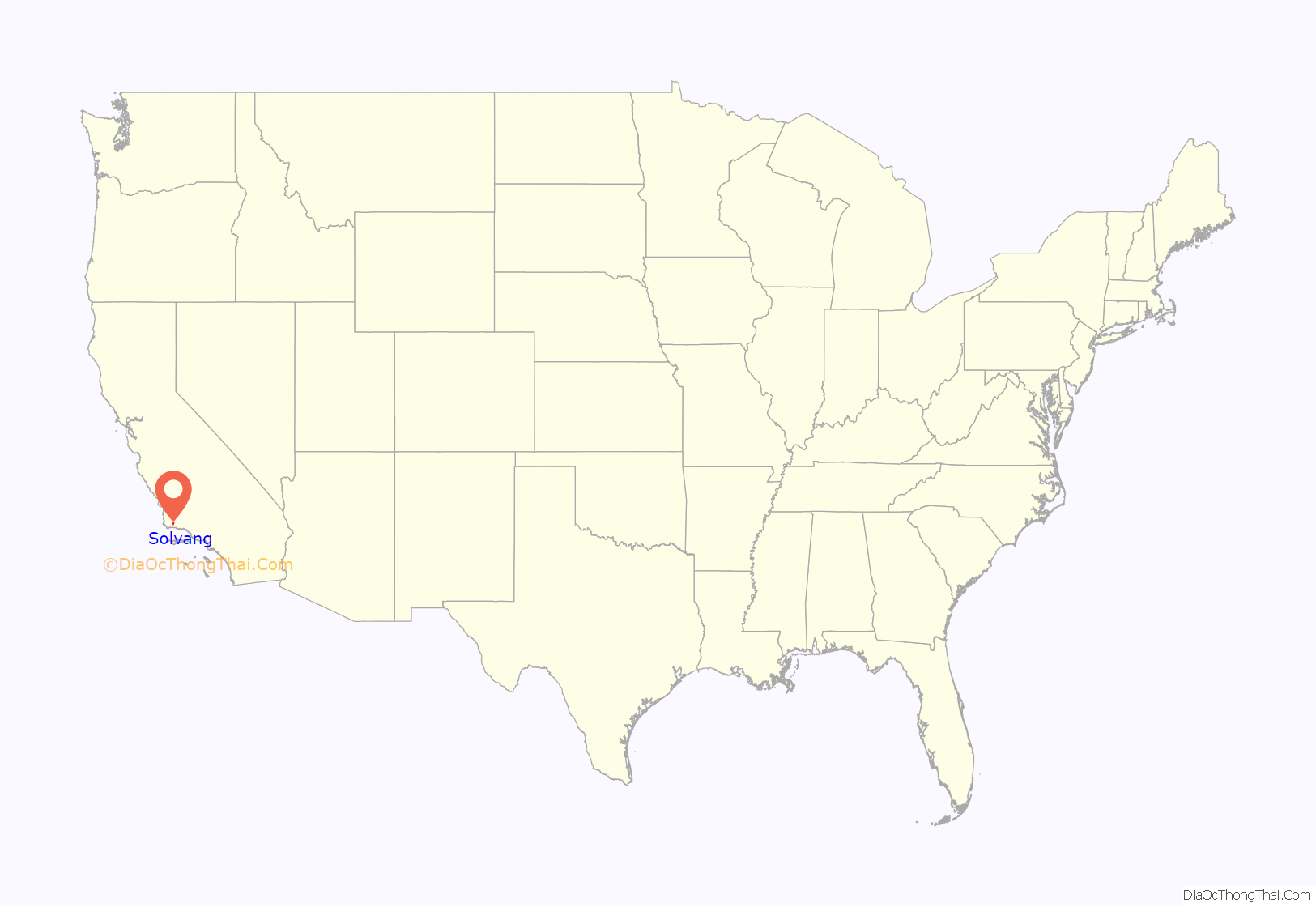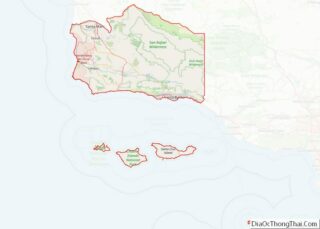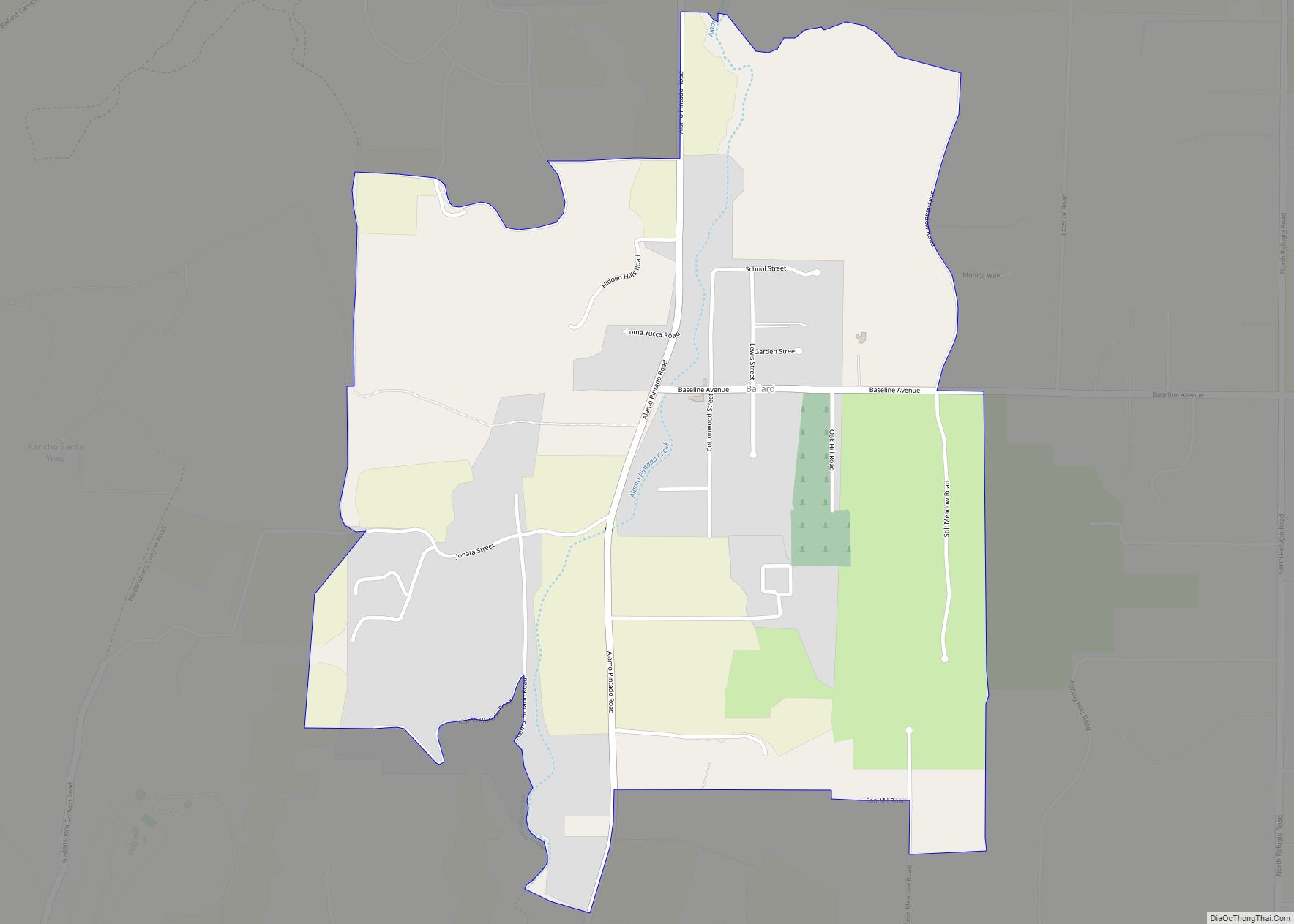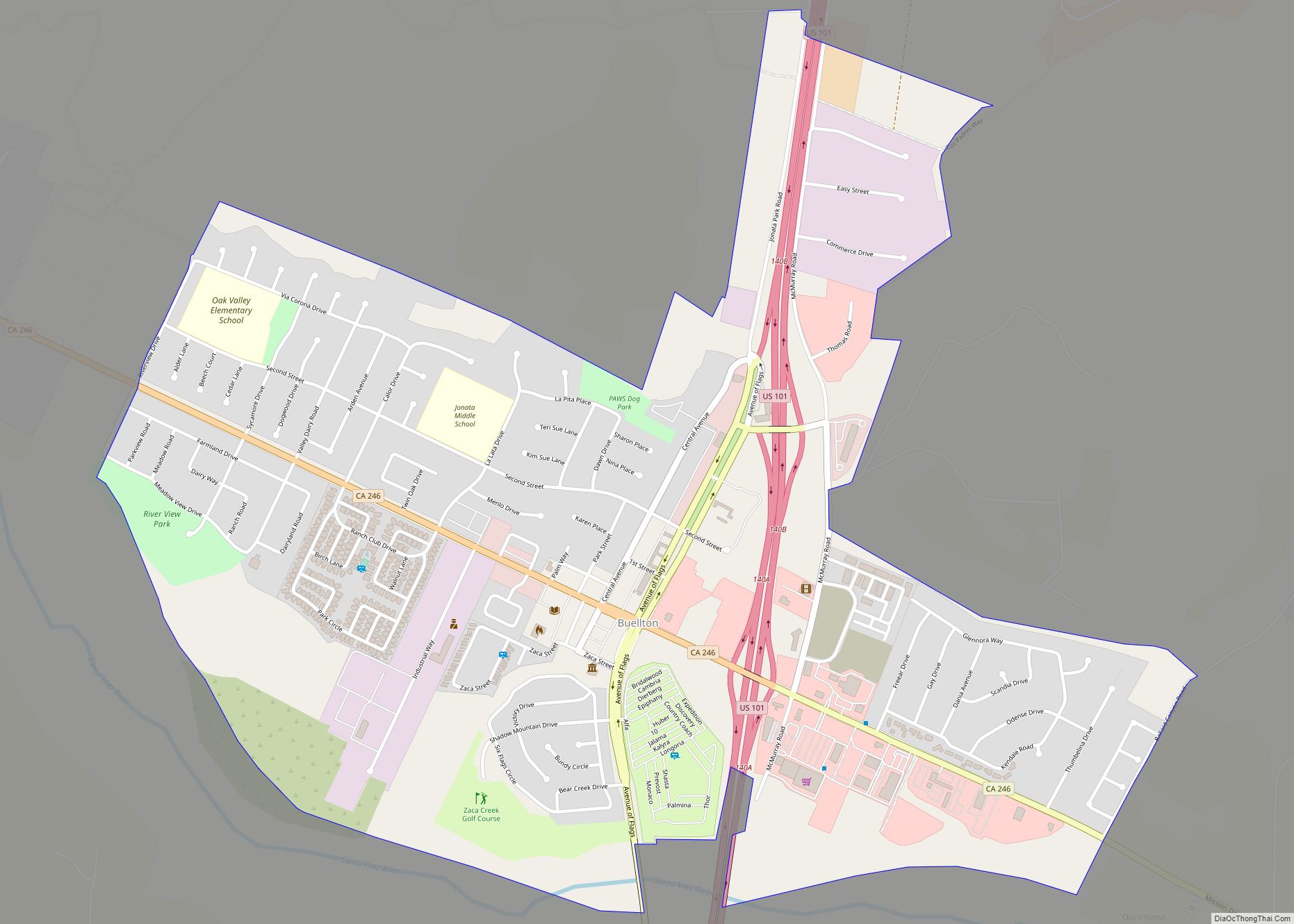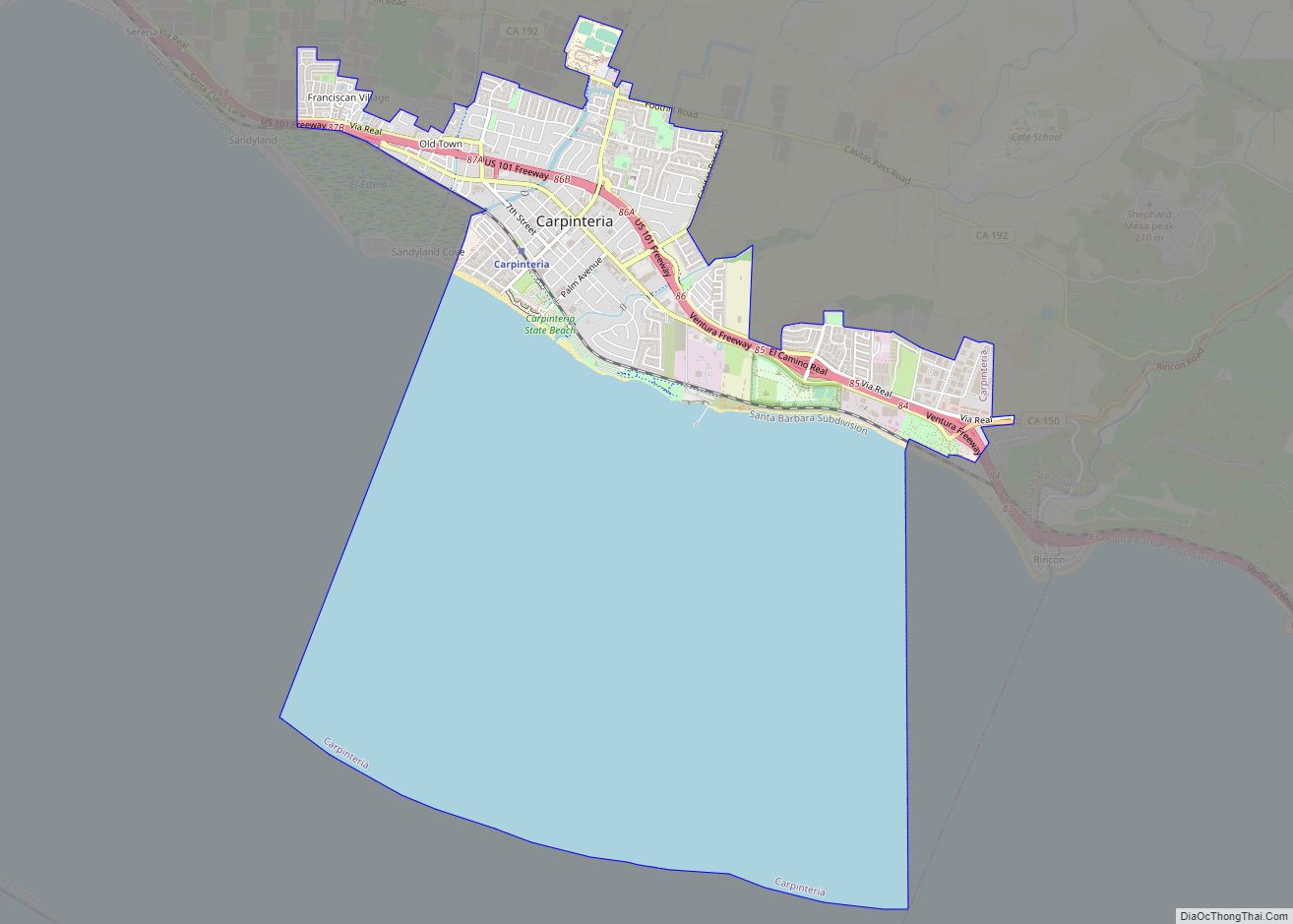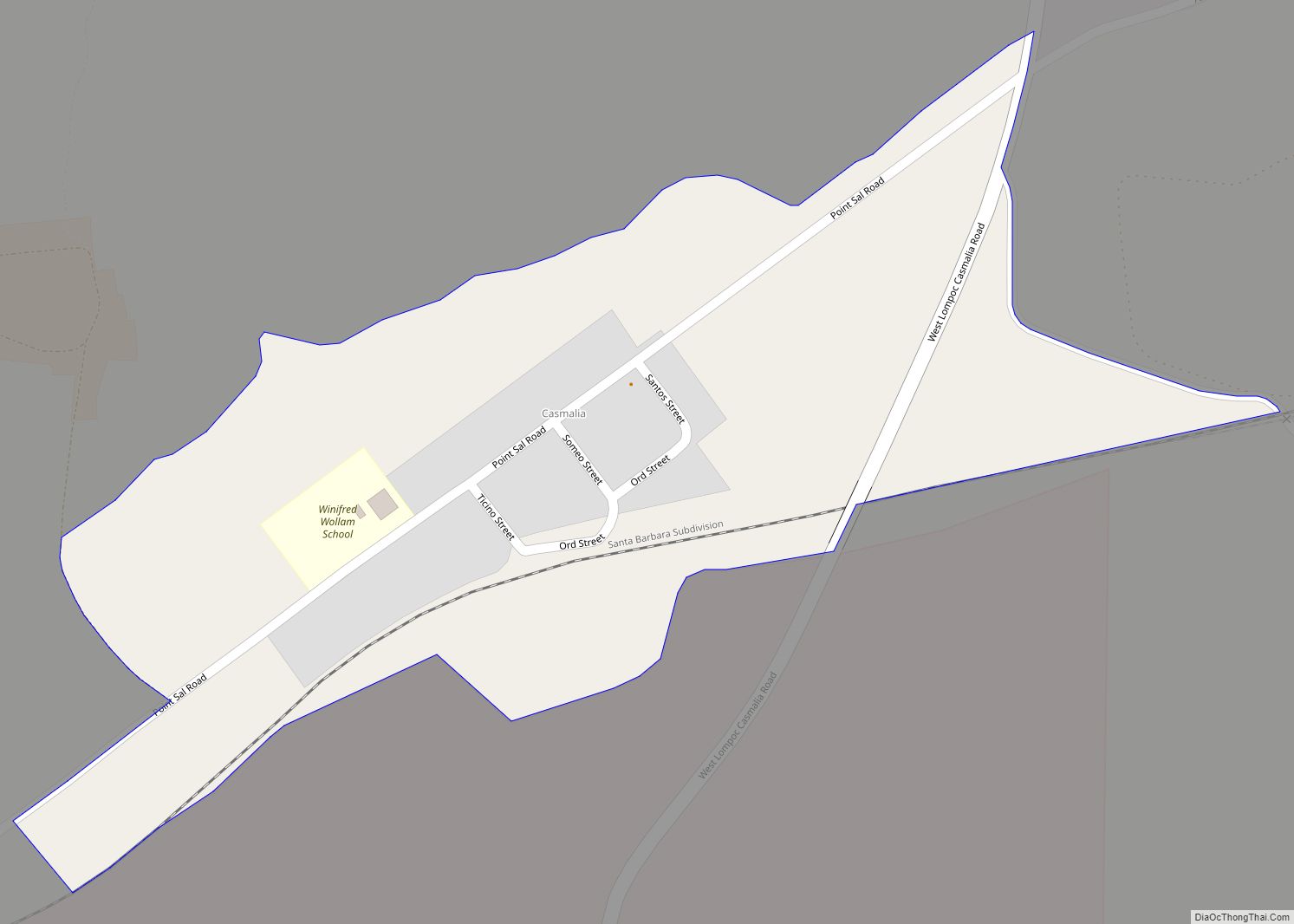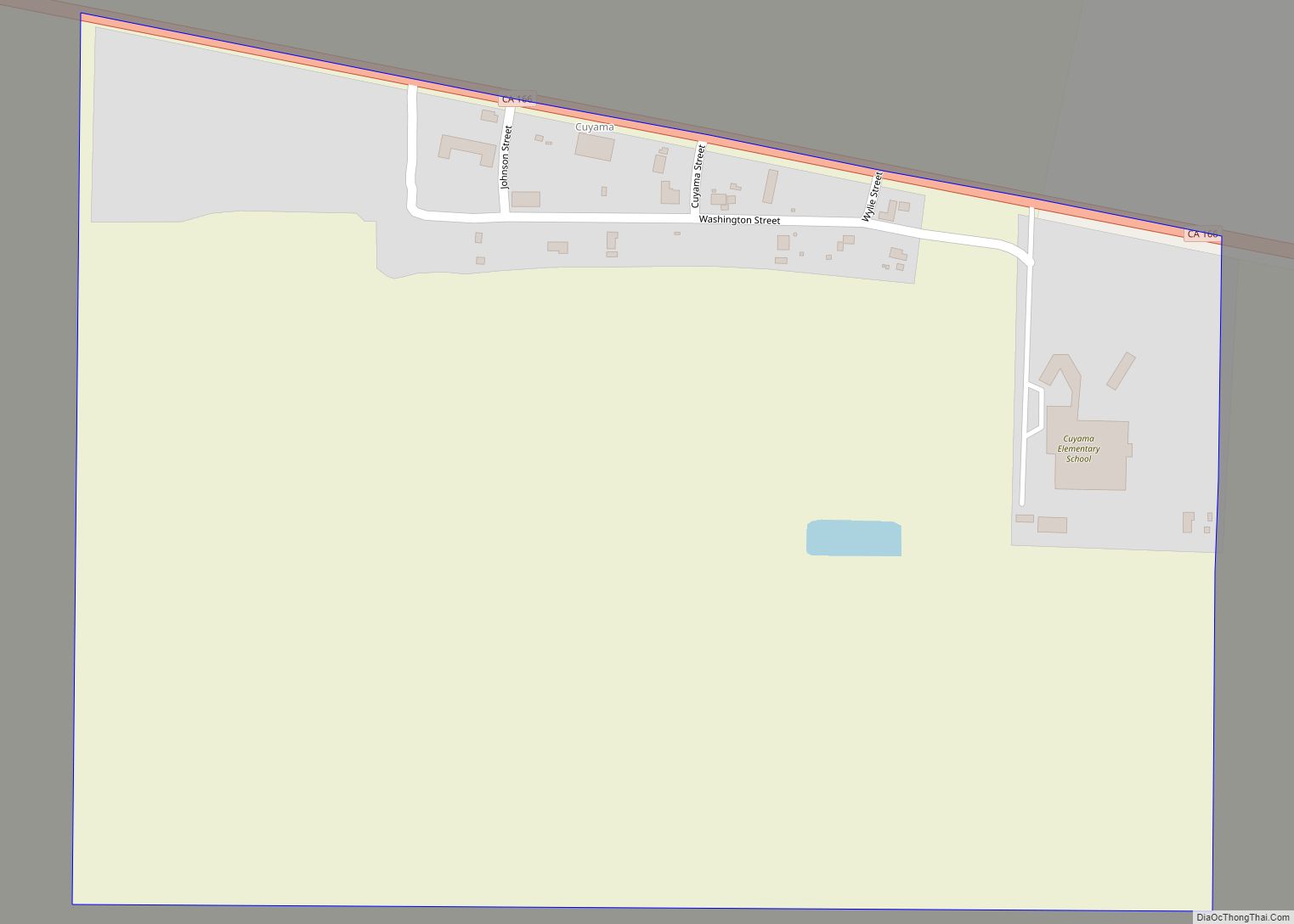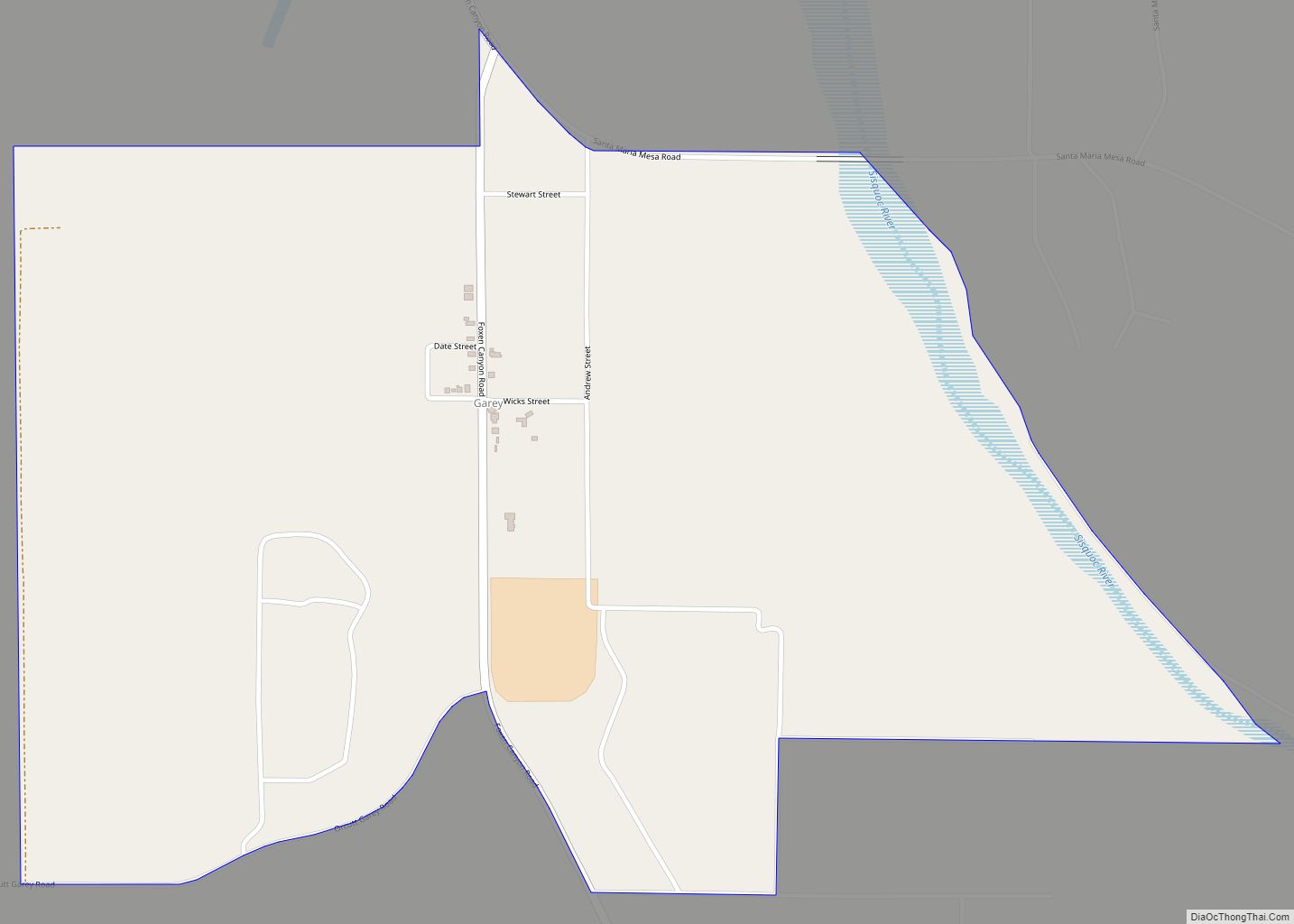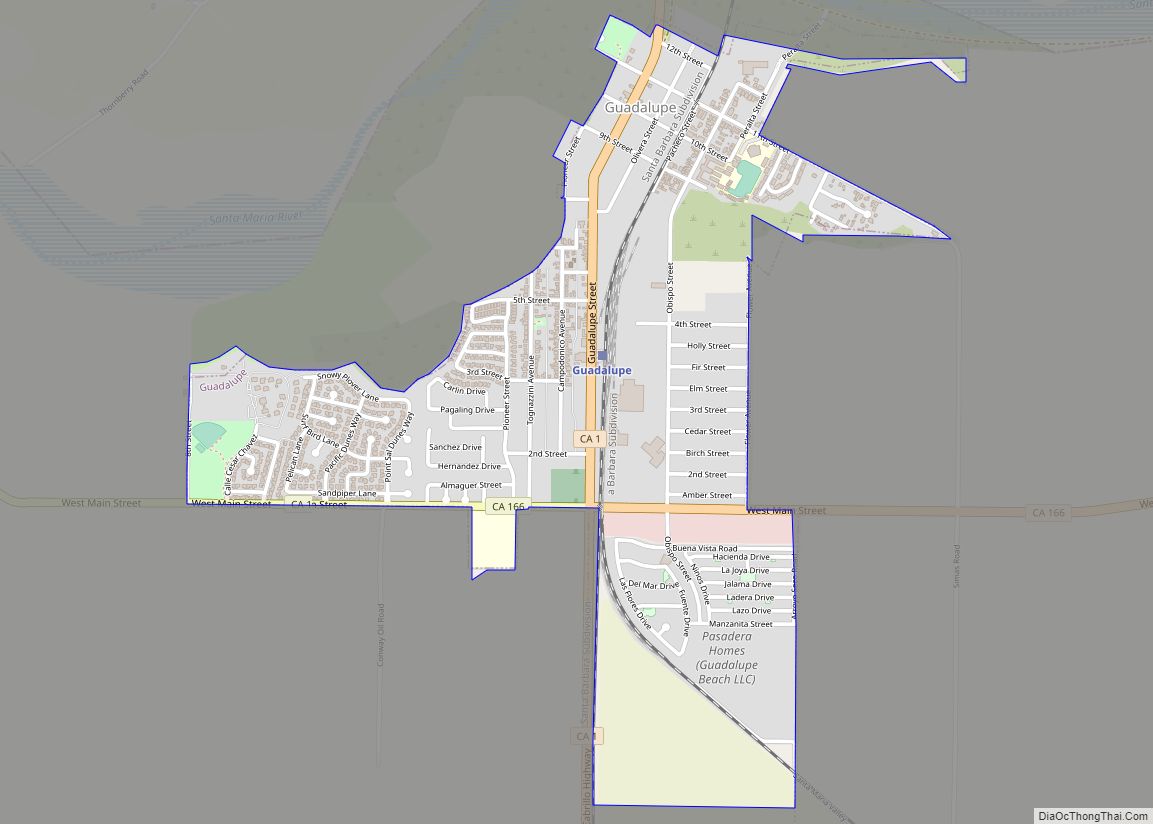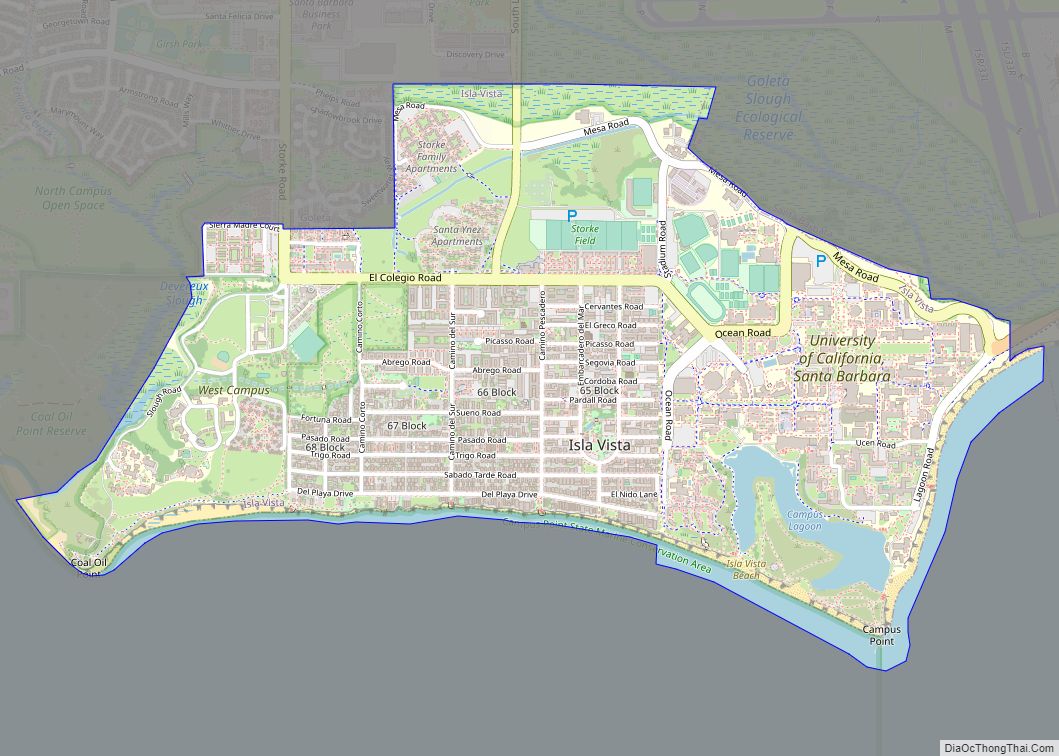Solvang (Danish for ‘sunny field’; /ˈsɒlvæŋ/) is a city in Santa Barbara County, California. It is located in the Santa Ynez Valley. The population was 6,126 at the 2020 census, up from 5,245 at the 2010 census. Solvang was founded in 1911 and incorporated as a city on May 1, 1985. Solvang is often dubbed “The Danish Capital of America”.
Solvang’s origins date back to 1804, when Mission Santa Inés was founded by the Spanish under Esteban Tápis. A small community grew up around the mission called Santa Inés during the Mexican period, but it was largely abandoned after the American Conquest of California. In 1911, a new settlement was founded around the mission by a group of Danish-Americans who purchased 9,000 acres (3,600 ha) of the surrounding Rancho San Carlos de Jonata, to establish a Danish community far from Midwestern winters. The community took on its distinctive Danish-themed architecture beginning in 1947 and has since become a prominent tourist destination. Though only about 10% of residents in the 21st century are Danish, the town attracts many tourists from the Nordic countries, and has been the subject of several Danish royal visits, most recently by Prince Henrik in 2011.
| Name: | Solvang city |
|---|---|
| LSAD Code: | 25 |
| LSAD Description: | city (suffix) |
| State: | California |
| County: | Santa Barbara County |
| Incorporated: | May 1, 1985 |
| Elevation: | 505 ft (154 m) |
| Total Area: | 2.43 sq mi (6.28 km²) |
| Land Area: | 2.42 sq mi (6.28 km²) |
| Water Area: | 0.00 sq mi (0.00 km²) 0.05% |
| Total Population: | 6,126 |
| Population Density: | 2,500/sq mi (980/km²) |
| Area code: | 805 |
| FIPS code: | 0672576 |
| Website: | www.cityofsolvang.com |
Online Interactive Map
Click on ![]() to view map in "full screen" mode.
to view map in "full screen" mode.
Solvang location map. Where is Solvang city?
History
Beginnings
The Santa Ynez Valley, in which Solvang lies, was originally inhabited by the Chumash, identified by Father Pedro Font, chaplain of the 1776 Anza Expedition, as an ingenious and industrious people. They have an excellent astronomical system and are good fishermen and hunters.
As part of the expansion of the mission system established in California by Spanish missionaries, Father Estévan Tapís founded Mission Santa Inés, now located near the center of Solvang, in order to relieve overcrowding at Mission Santa Barbara and Mission La Purísima Concepción since it was located midway between the two. It also served as a gateway to the Chumash Indians living east of the Coast Range.
After the Mexican War of Independence, the Mexican Assembly passed the Secularization Laws which confiscated Mission lands, along with other property, and transferred them to the control of local ranchers, with Solvang being later founded on what became known as the Rancho San Carlos de Jonata. With secularization, Mission Santa Inés began to decline and the Chumash Indian population in the area along with it. For a time, the mission was a seminary but soon began to deteriorate. However, it was repaired by the Donahue family in 1884 and renovated by Fr. Alexander Buckler in 1904.
Danish immigrants
Between 1850 and 1930, a considerable number of Danes left Denmark, which was suffering from poor economic prospects. According to some estimates, as many as one in ten Danes emigrated during this period, mostly to the United States. The most popular destinations for Danish settlers were Utah, Wisconsin, Illinois, Minnesota, Iowa, Nebraska, and South Dakota. In many of the new communities, churches and schools were set up in accordance with the ideas of N. F. S. Grundtvig, an influential Danish philosopher, hymn-writer and Lutheran pastor. In particular, the so-called folk schools introduced a new approach to education based on a spirit of freedom, poetry and disciplined creativity. Folk schools were established in Elk Horn, Iowa (1878–1899); Grant, Michigan (1882–1888); Nysted, Nebraska (1887–1934); Tyler, Minnesota (1888–1935); and Kenmare, North Dakota (1902–1916); and finally in Solvang (1911–1931).
One of the most enthusiastic proponents of the Danish approach to religion and education was Benedict Nordentoft, who was born in Brabrand near Aarhus in 1873. After graduating in theology in 1898, he was soon tempted to travel to the United States, where he began coordinating relations between Danish Lutheran churches in Michigan, Ohio, New Jersey, New York, Connecticut, Massachusetts and Maine. In 1901, he returned to Denmark specifically to be ordained in Aarhus Cathedral. Back in America, he continued his work as a lecturer at Grand View College, a folk high school in Des Moines, Iowa, which was also set up by the Danish Lutheran Church. He was appointed president in 1903, a post which he held until 1910, when disagreements with his Grundtvigian colleagues forced him to resign.
From 1906, Nordentoft, together with Jens M. Gregersen, a pastor from Kimballton, Iowa, and Peder P. Hornsyld, a lecturer at Grand View, had discussed the possibility of creating a new Danish colony with a dedicated Lutheran church and school on the west coast. In 1910, together with other Danish-Americans, they created the Danish-American Colony Company in San Francisco. Later that year, suitable land was found in the Santa Ynez Valley northwest of Santa Barbara. On January 23, 1911, the contract was signed and Solvang was founded. The Danes had bought almost 9,000 acres (36 km) of the Rancho San Carlos de Jonata land grant, paying an average of $40 per acre.
Among the other early arrivals with Mads Frese were Mr. and Mrs. Sophus Olsen, Hans Skytt, John Petersen and John Ahrenkild. Skytt was to play an important role as the carpenter, who constructed many of Solvang’s early buildings. The first to be constructed was a hotel close to the Mission where new arrivals could be housed. Gregersen became president of the Danish-American Colony Company, and Nordentoft was named head and Hornsyld a teacher at the school, which opened on November 15, 1911, with 21 students.
Expansion
At the end of 1912, when it became almost impossible to sell any more plots of land, the company’s income was vastly reduced. The shareholders persuaded Gregersen to give up his position as Solvang’s pastor and travel to Iowa and Nebraska to convince Danish immigrants to buy land in the new colony. He enjoyed considerable success, relieving the colony of any further threats. After Gregersen’s departure, Nordentoft became the pastor. Before long, Solvang also had a store, a bank, a lumber yard, a barbershop and a post office with Hornsyld as postmaster. Where there had just been fields, there was now a small town.
Folk high school
Nordentoft was not content with the little folk school in Solvang. When he was unable to convince Gregersen and Hornsyld that a larger educational institution was needed, he bought them out and started to raise funds for a bigger and better school. The following year, in August 1914, a rejsegilde or topping-out ceremony was held for the impressive new building, which Nordentoft called Atterdag College in memory of Valdemar Atterdag, who did much to consolidate the kingdom of Denmark in the 14th century. What surprised many of those who came to the celebration was the great similarity the building had with Grand View College. Standing on a hilltop above the village, the new college or folk high school was designed to teach Danish-speaking students in their late teens how to lead more meaningful lives with an emphasis on lectures, singing, gymnastics, folk dancing and fellowship. A difficult period followed, as World War I put a stop to Danish emigration to America, leading to a reduction in the number of young people requiring a school education. It also became difficult to maintain a Danish-speaking school at a time when American nationalism was steadily growing. Nordentoft, who felt he had achieved his ambitions in America, sold the college to the congregation of the Solvang Lutheran church in 1921 for $5,000 and returned to Denmark with his wife and family. Atterdag College continued to be used as a folk school, a community meeting hall, a performing arts venue, a gymnastics center, a summer school, and a boarding house until it was finally demolished in 1970, making way for the Solvang Lutheran Home.
Danish church
The Bethania Evangelical Lutheran Church was initiated by the Danish pioneers in 1912. For a number of years, church services were held in the school building until, in 1928, a new church was built by Hans Skytt and his colleagues. Solidly constructed in ferro-concrete with walls a foot thick, it was based on a photograph of a Gothic-styled Danish church and resembles one of the hundreds of rural churches in Denmark which were built or restyled in the 14th century. Its interior contains hand-carved woodwork on the altar, pulpit and altar rail. Services used to be mainly in Danish but apart from a Christmas service in Danish on lillejuleaften (December 23) each year, all the other services are in English.
Danish-styled architecture
Initially, most of Solvang’s buildings were built in the same style as others in the area. The Lutheran church was the first to be based on Danish architecture and bears a close relationship to Danish equivalents. But after World War II, interest grew in the concept of a “Danish Village”. The pioneer of the Danish Provincial style was Ferdinand Sorensen, originally from Nebraska. In the mid-1940s, after returning to Solvang from a trip to Denmark, he first completed Møllebakken, his Danish-styled home, and then went on to build the first of the village’s four windmills. A little later, Earl Petersen, a local architect, gave the older buildings a new look, adding façades in so-called “Danish Provincial” style. Buildings in the half-timbered style of Danish rural houses proliferated, creating a new tourist attraction. While much was done to create an “authentic” Danish atmosphere in the town center, it has been pointed out by Scandinavians that fake thatched roofs and artificial timbering are largely a result of local interests in general rather than those of the Danish immigrants themselves. The older buildings have simply been restyled to look Danish even if there was nothing Danish about them originally.
Subsequent development
During the 1920s, the proportion of non-Danish residents rose substantially and local businesses and churches began providing services in English, in addition to traditional Danish. In the 1930s, Solvang became the largest town in the Santa Ynez Valley and a commercial hub for the local region. By the late 1940s, Solvang’s growth stagnated as the town’s economic activity focused predominately on agriculture, prompting younger residents to leave in search of more diverse job opportunities. In 1947, the town was featured in an article in The Saturday Evening Post entitled “Little Denmark”, which praised Solvang’s quaint rural charms and sparked a tourism boom prompting residents of Los Angeles and San Francisco to take weekend trips to Solvang. Solvang subsequently developed a tourism industry focused on emphasizing the town’s Danish heritage. The 2004 film Sideways, brought attention to the vineyards in the surrounding Santa Ynez Valley and tasting rooms have opened. Restaurants are also part of the revitalization of Solvang as it becomes a destination for locally sourced fare.
Solvang Road Map
Solvang city Satellite Map
Geography
Solvang is located at 34°35′38″N 120°8′23″W / 34.59389°N 120.13972°W / 34.59389; -120.13972. At an elevation of 505 ft (154 m), it lies in the Santa Ynez Valley some 46 miles (74 km) north-west of Santa Barbara and about 15 miles (24 km) north of the Pacific coast. According to the United States Census Bureau, the city has a total area of 2.4 square miles (6.2 km), 99.95% of it land and 0.05% of it water.
Climate
Solvang enjoys sunshine throughout the year with clear, warm days and cool nights. Average temperatures vary between 52 and 72 °F (11 and 22 °C) with highs reaching the lower 90s °F (lower 30s °C) and winter lows in the upper 30s °F (below 5 °C). Furthermore, Solvang experiences large diurnal temperature variations, especially in the summer, when daily temperatures vary on average by almost 40 °F (20 °C). Average annual rainfall for Solvang (recorded between 1964 and 2010) is 19.31 inches (49 cm).
Solvang is 140 miles (230 km) north of Los Angeles.
See also
Map of California State and its subdivision:- Alameda
- Alpine
- Amador
- Butte
- Calaveras
- Colusa
- Contra Costa
- Del Norte
- El Dorado
- Fresno
- Glenn
- Humboldt
- Imperial
- Inyo
- Kern
- Kings
- Lake
- Lassen
- Los Angeles
- Madera
- Marin
- Mariposa
- Mendocino
- Merced
- Modoc
- Mono
- Monterey
- Napa
- Nevada
- Orange
- Placer
- Plumas
- Riverside
- Sacramento
- San Benito
- San Bernardino
- San Diego
- San Francisco
- San Joaquin
- San Luis Obispo
- San Mateo
- Santa Barbara
- Santa Clara
- Santa Cruz
- Shasta
- Sierra
- Siskiyou
- Solano
- Sonoma
- Stanislaus
- Sutter
- Tehama
- Trinity
- Tulare
- Tuolumne
- Ventura
- Yolo
- Yuba
- Alabama
- Alaska
- Arizona
- Arkansas
- California
- Colorado
- Connecticut
- Delaware
- District of Columbia
- Florida
- Georgia
- Hawaii
- Idaho
- Illinois
- Indiana
- Iowa
- Kansas
- Kentucky
- Louisiana
- Maine
- Maryland
- Massachusetts
- Michigan
- Minnesota
- Mississippi
- Missouri
- Montana
- Nebraska
- Nevada
- New Hampshire
- New Jersey
- New Mexico
- New York
- North Carolina
- North Dakota
- Ohio
- Oklahoma
- Oregon
- Pennsylvania
- Rhode Island
- South Carolina
- South Dakota
- Tennessee
- Texas
- Utah
- Vermont
- Virginia
- Washington
- West Virginia
- Wisconsin
- Wyoming
